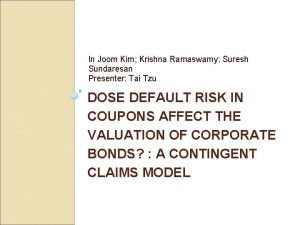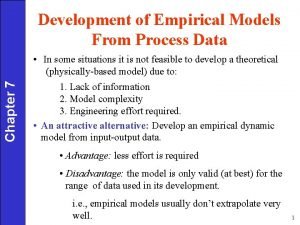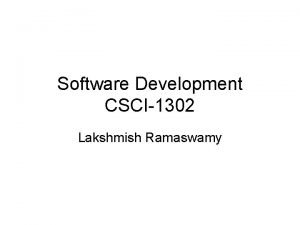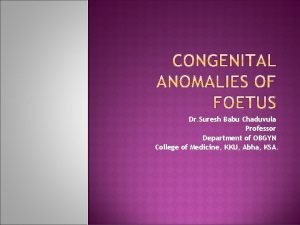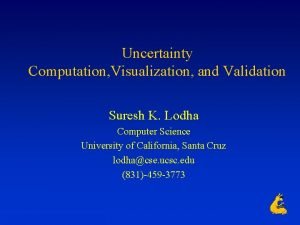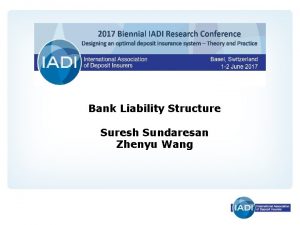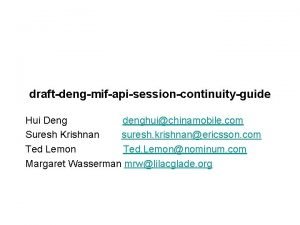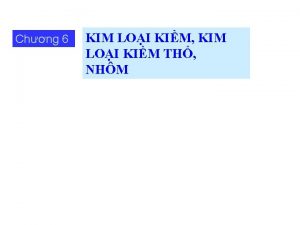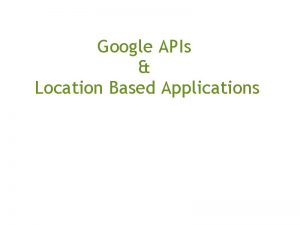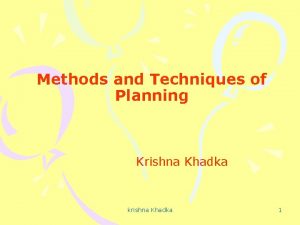In Joom Kim Krishna Ramaswamy Suresh Sundaresan Presenter


















- Slides: 18

In Joom Kim; Krishna Ramaswamy; Suresh Sundaresan Presenter: Tai Tzu DOSE DEFAULT RISK IN COUPONS AFFECT THE VALUATION OF CORPORATE BONDS? : A CONTINGENT CLAIMS MODEL

INTRODUCTION • Black and Scholes, Merton : use theory of option pricing corporate liabilities. • Brennan and Schwartz, Ingersoll : price convertible and callable corporate liabilities. • Merton: unable to generate default premiums > 120 basis points • Jones, Mason and Rosenfeld: stochastic interest rates might improve the performance of contingent claims pricing models.

Contingent claims model No taxes, transaction costs or information asymmetries. Value of firm V follows the log-normal diffusion process; firm’s capital structure consists of equity and a single, coupon bond with principal P. Stochastic interest rate The possibility of the firm defaults on its coupon obligations Call provision

I The valuation of Noncallable Corporate Bond The firm’s value V follows: ◦ α is the instantaneous expected return rate ◦ γV is the net cash outflow which is independent of the capital structure of the firm. Short rate (CIR model) The payoffs to bondholders upon bankruptcy follows: when V=V*, the payoff is ◦ B(r, τ; c) is the value of a comparable Treasury bond with a time-tomaturaty given by τ and δ(τ) is a positive fraction. ◦ δ(0)=1, bondholders are promised P or V , whichever is less, at maturity.

Assumptions Prohibit the stockholders from selling the assets of the firm to pay dividends. Coupon to bondholders (priority) Lower boundary V*= c/γ Not allow for either new equity issues or side-payments (ex. reorganization) Managers have an incentive to reduce the amount of planned investment and pay the coupon in order to avoid bankruptcy. Brennan and Schwartz rule: bondholders will take over the firm when the firm’s value < a fraction of the par value of the bond. δ(τ)B(τ; c) < payoff if bondholders forego coupons for next n months and receive higher level of coupons thereafter.

The valuation equation W( V, r, τ; c): corporate bond value ◦ Boundary condition (V -> infinity => W ( V, r, τ; c)-> comparable default-free bond B ( r, τ; c): ) ◦ Terminal condition:

II Numerical Solutions to the Valuation Equation for Noncallable Bonds Face value P=$100 Interest rate r=μ=9%, σ2=0. 0; σ1=0. 15 Recovery factor δ=0. 8 Net cash flow ratio γ=0. 05 Ex. Dabt ratio=30%, coupon rate=9%, dividend yield=3. 5% =>γ=0. 3*0. 09+0. 7*0. 35=0. 0515 Exhibit 2 : close to market spreads at conventional debt level, it seems preferable to us to move contingent claims modeling effort in the direction of valuing couponbearing bonds with the possibility of premature default, rather than increase P/V=50% P/V=25%

Debt ratio(0. 42; 0. 33; 0. 28) The capital structure of the firm has a significant effect on the shape of the term structure of yield spreads. High debt ratio: investors holding short-term bonds are exposed to the more significant possibility of default on the balloon payment (只付利息 不 還本金). Low debt ratio: long-term bonds are riskier than short-term bonds because more coupons are subject to default risk.

Interest rate and recovery factor ØP=$100, r=μ=9%, σ1=0. 15, κ=0. 5, ρ=0. 2, σ2=0. 078 ØRecovery factor δ=0. 8 (表 6), 0. 4(表 7) ØNet cash flow ratio γ=0. 05 ØSpread=82 (表 2 V=240, r=9%, P/V=0. 42σ2=0. 0 ) ØSpread=37 (γ=0. 06, P/V=0. 42) Uncertainty in the interest rate(σ2) significantly influenced the yields on both Treasury and corporate issues. Thus, the interest rate risk is independent of default risk. The yield spread can be very large for low-grade bonds with a small recovery factor. Interest rate decreases => present value of default risk increases ◦ This should cause the spread to widen significantly. The higher is the net cash flow ratio, the lower is the yield spread. ◦ Because given a firm’s value, a higher net cash flow means the firm is more likely to meet coupon obligations.

III The numerical solutions for callable corporate bonds Corporations issue debt with call features to refinance the debt. Total spread: the yield differential between a callable corporate bond an otherwise similar but noncallable Treasury bond. Call premium: the difference in the yields of callable and noncallable, but similar (either Treasury or corporate) bonds. Optimal call policy: the issuing firm to retire the bond when the interest rate R(τ) is low and the value of the firm C(τ) is high. Thus, the upper bond condition follows: ◦ G (C(τ), R(τ), τ; c) is the value of a callable corporate bond and K is the fixed call price.

Call provision At debt ratio 42%, interest rate 9%, the call provision of the bond is 22 basis point. (103 -81=22) a b

Optimal call policy At low firm values, the issuing firm waits much longer before calling the bonds. The trade-off here is that a decision to call forces an immediate cash outflow but relieves the firm of its (now) high coupon binds. At long-term maturity, critical interest rate of Treasury bond is lower than corporate bond. ◦ As default risk serves to reduce the value of corporate bond, it takes lower interest rates to raise the value of the corporate bond to the call price.

The shape of the curves is the same regardless of the debt ratio

Callable Treasury bond H(r, τ; c): callable, coupon-bearing Treasury bond will satisfy a valuation equation and reflect an optimal call policy R*(τ). It’s partial differential equation follows (which is equivalent to setting Hv to zero in eq 4):

At debt ratio 42%, interest rate 9%, the call provision of Treasury bond is 44 basis point and is larger than call provision of corporate bond (103 -81=22).

Call protection With the call protection, yields are lower, since the protection feature works to the advantage of the buyers. Call protection: bonds are callable during the last five years.

The effect of interaction between default risk and call provision Total spread (callable corporate –straight government)=1. 03% Default risk (straight corporate –straight government)=0. 81% The contribution of the call provision to total spread (callable government –straight government ) =0. 45% Interaction between default risk and call provision is 0. 23%. (0. 81%+0. 45%-1. 03%)

IV Summary Model stochastic interest rates and the importance of cash flow shortages in precipitating bankruptcy. Stochastic interest rates seem to play an importance role in determining the yield differentials between a callable corporate bond an equivalent government bond due to the interactions between call provisions and default risk. This suggests that care should be taken in interpreting empirical results regarding the effect of default risk on the values of callable corporate bonds.
 Krishna ramaswamy
Krishna ramaswamy Sundaresan and krishnaswamy method
Sundaresan and krishnaswamy method Lakshmish ramaswamy
Lakshmish ramaswamy Prema ramaswamy md
Prema ramaswamy md What is the result of following vik null ram
What is the result of following vik null ram Www.gurudeva.com new
Www.gurudeva.com new Lalith suresh
Lalith suresh Dr rajendran suresh
Dr rajendran suresh Bindu suresh md
Bindu suresh md Kattera suresh babu
Kattera suresh babu Www.gurudeva.com new
Www.gurudeva.com new Dr suresh gupta ganga ram hospital
Dr suresh gupta ganga ram hospital Suresh lodha ucsc
Suresh lodha ucsc Dr suresh kattera
Dr suresh kattera Srivasadi gaura bhakta vrinda
Srivasadi gaura bhakta vrinda Sri krishna caitanya prabhu nityananda
Sri krishna caitanya prabhu nityananda Dr murali krishna voona
Dr murali krishna voona Sree krishna college of engineering vellore
Sree krishna college of engineering vellore Krishna education centre
Krishna education centre
